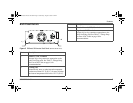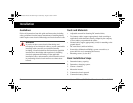
975-0529-01-01 11
Installation
Fuse/Circuit Breaker Sizing Guidelines
Because batteries can produce thousands of amps, you are required
to install DC-rated fuses (or circuit breakers) that can safely
withstand the short-circuit current batteries can produce.
To select the correct fuse type and size:
1. Determine the total cold cranking amp rating for your
battery(s).
Note: The cold cranking amp rating of each battery is displayed
on the battery case. If it is not, contact the battery manufacturer
to find out.
For example:
• If you are using one battery to power your inverter and its
rating is 500, the total cold cranking amp rating is 500.
• If you are powering your inverter with two batteries in
parallel, and each has a rating of 500, the total cold
cranking amp rating is 1000.
2. Once you have determined the total cold cranking amp rating of
your batteries, identify the corresponding Ampere Interrupting
Capacity (AIC) of the fuse or breaker required for your system
by referring to Table 2.
Note: The AIC is the amount of battery short-circuit amperage
that the fuse can safely withstand.
• If the Total Cold Cranking Amps indicate that the AIC is
2,700 amps or less, see Table 3 for the correct ANL fuse.
• If the Total Cold Cranking Amps indicate that the AIC is
up to 200,000 amps or if you require a “code fuse”, see
Table 3 for the correct Class T fuse.
Table 2
Cold Cranking Amps / AIC
Total Cold Cranking
Amps
Ampere Interrupting Capacity
(AIC)
650 or less 1500
651–1100 3000
over 1100 5000
Table 3
Fuse Ratings
Model ANL Fuse Class T
PROwatt SW 600 80 A 80 A
PROwatt SW 1000 150 A 150 A
PROwatt SW 2000 250 A 250 A
PROWatt SW Inverter NA.book Page 11 Wednesday, August 5, 2009 2:24 PM


















